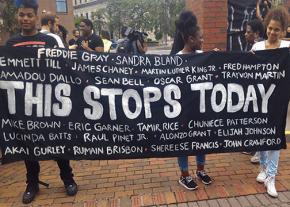We won’t be preyed upon
reports from Syracuse, New York, on a demonstration for Black lives.
MORE THAN 400 people joined a July 18 protest and march against racist police violence in Syracuse, New York. The event was organized by a newly formed Black Lives Matter chapter.
Homeland Security warned local business and federal employees to close and leave the downtown area before the rally. Many offices and businesses did close. Police could be seen on nearby rooftops taking photographs of demonstrators.
In addition to protesting the police murders making national news--Philando Castile and Alton Sterling--Syracuse activists called attention to local shootings, the most recent at a Father's Day picnic where police shot Gary Porter to death. In February, police shot and killed Sahlah Ridgeway in her home. In both cases, the officers involved were never indicted.
The misconduct of 11 Syracuse police officers has generated a quarter of all complaints against Syracuse's roughly 400-officer police department since 2012, according to the Syracuse Post-Standard. But the identities and details of the officers with all the complaints are kept secret.

THE LATE afternoon rally started at the Jerry Rescue monument, an abolitionist landmark in Syracuse. The statue commemorates the 1851 rescue of escaped slave William "Jerry" Henry by several hundred abolitionists congregating in Syracuse during an anti-slavery Liberty Party Convention. The abolitionists faced off against police, who had detained Henry based on the Fugitive Slave Law, to break Henry out of jail and usher him to safety in Canada.
Black Lives Matter leader Sequoia Kemp noted the significance of the statue:
We are concerned citizens gathered together to protest the extrajudicial killings of Black people in our country and city. The Jerry Rescue statue is a symbol of abolition and, more importantly, of the collective power of the people. We have come together to storm the prison again to free our Black siblings.
At the kickoff rally, a speaker invoked the spirits of Harriet Tubman, Sojourner Truth, Malcolm X and other Black liberationists to set the tone of the event. She read a statement of purpose from the Black Lives Matter national website to stress how the movement goes beyond Black nationalism and a focus on police murders to take on sexism and the oppression of trans and undocumented women, putting their voices in the forefront of the struggle.
The marchers' chants echoed off downtown buildings as the hundreds of participants made their way toward City Hall. "Hey hey, ho ho, these racist cops have got to go!" A banner bearing the famous words of Black abolitionist Frederick Douglass--"Power concedes nothing without a demand; it never has and it never will"--led the march. This banner was signed by the "General Body," the large and militant activist movement that shook Syracuse University last year.
Another large banner read, "This stops today." It listed the names of Black men and women killed by racist police and vigilantes--from Fred Hampton, Emmett Till and Martin Luther King Jr., to Oscar Grant, Amadou Diallo, Trayvon Martin, Freddie Gray and Sandra Bland. In this way, the activists connected up the struggles historically for black liberation, against the New Jim Crow and against the death penalty.
At a stop at City Hall, a poet insisted, "We are not prey! That's why we're here today." Then the marchers headed to the police station, chanting, "Get up, get down, Black Lives Matter has come to town!"
At the jail, there was a reading of names of a number of Black people killed in Syracuse by what an activist referred to as "our so-called protectors." She added: "We want Black liberation and an end to white supremacy, homophobia, and sexism--and we want it now! We want Black lives to matter now. We want them to stop killing us!
Brittney Bledsoe led the group in song: "I can hear my brother sayin' I can't breathe, now I'm in the struggle sayin' I can't breathe, calling out the violence of these racist police, and we're not going to stop until people are free."
Bledsoe and other activists stressed that one purpose of the rally was to unify Syracuse and involve more activists, whatever their differences. One way to make such unity a reality would be to hold open organizing meetings and invite a broad spectrum of organizations and individuals to participate.
Sequoia Kemp brought the rally to a close with the powerful call-and-response chant attributed to Assata Shakur: "It is our duty to fight for our freedom. It is our duty to win. We must love and support each other. We have nothing to lose but our chains!"


